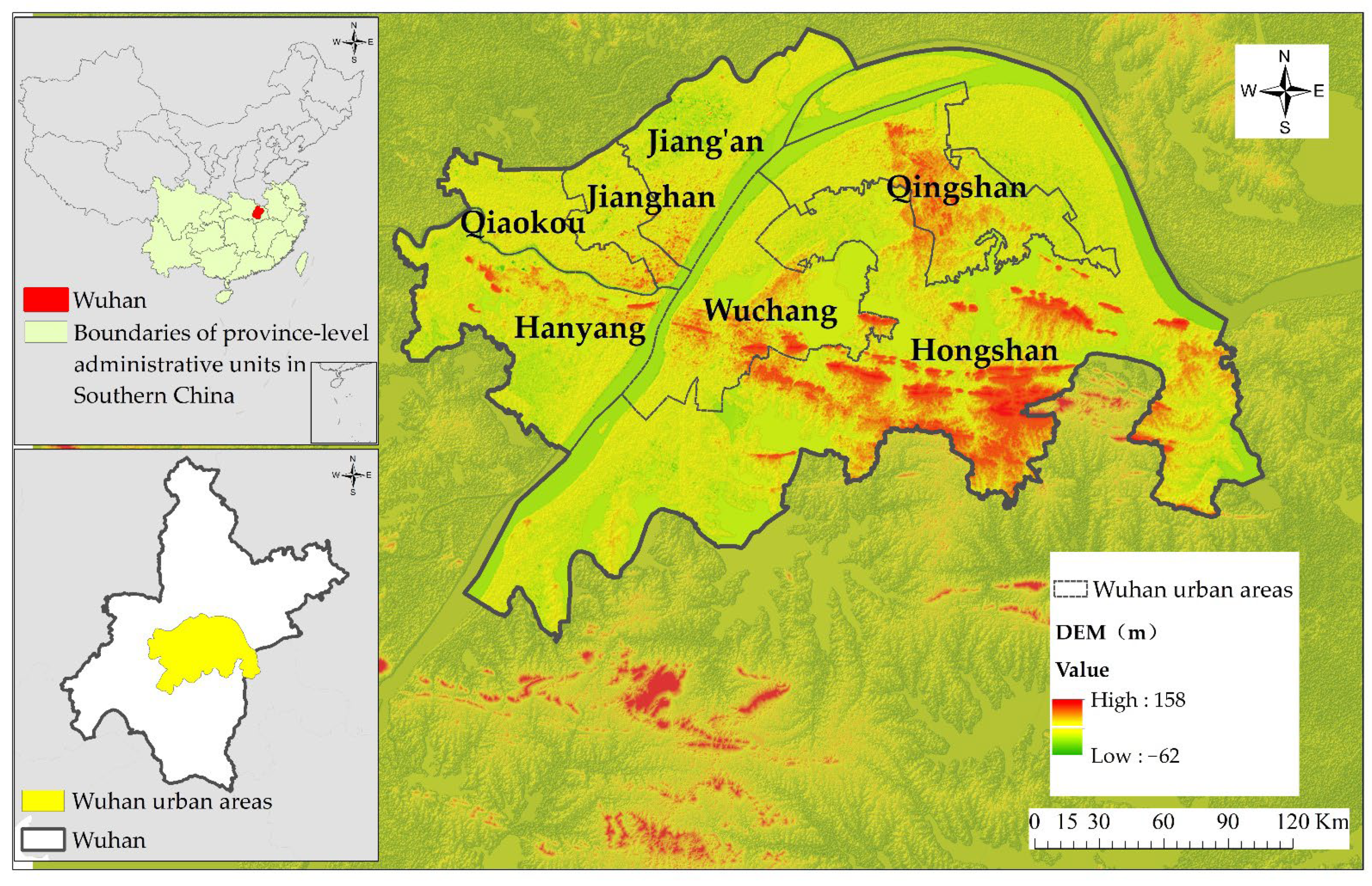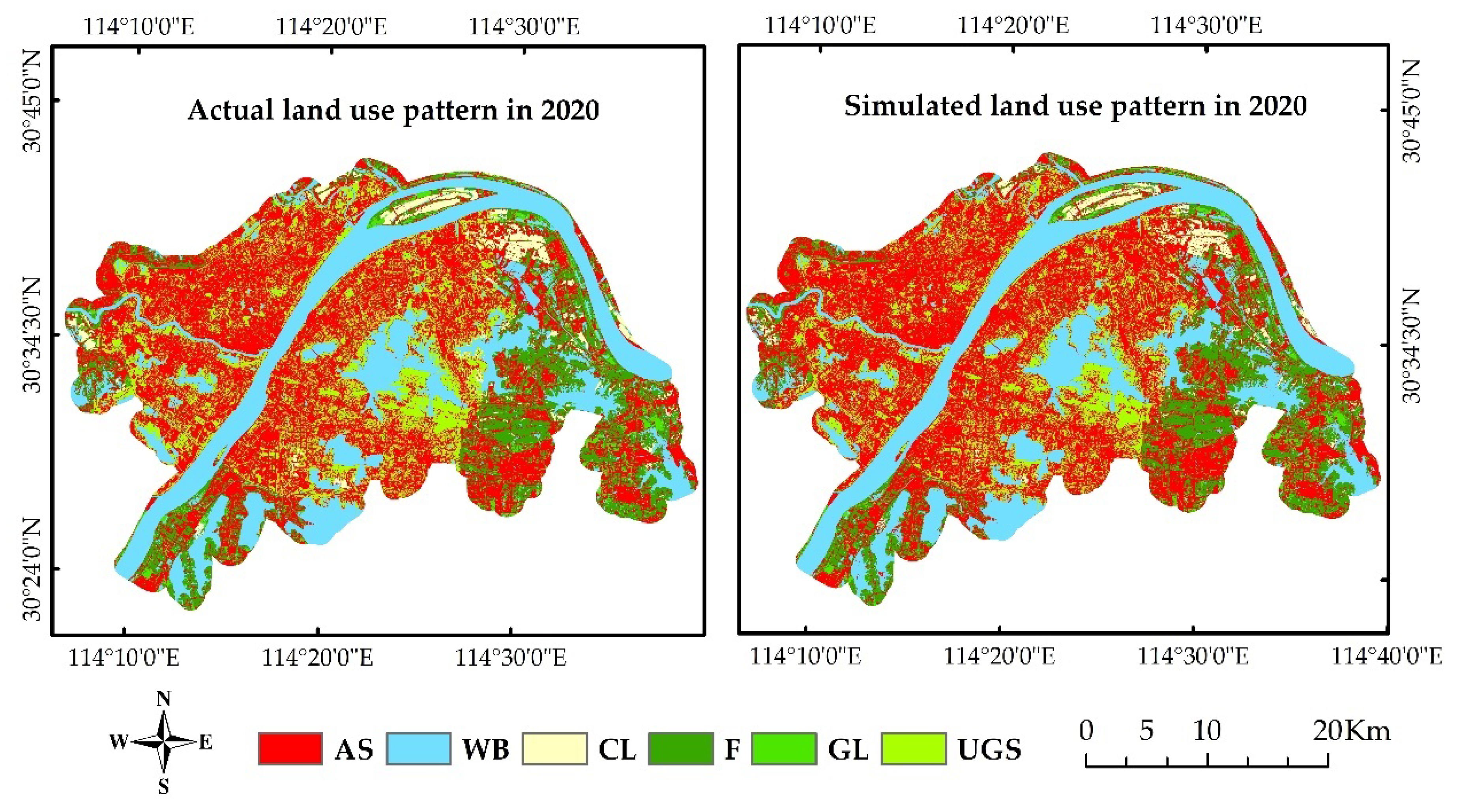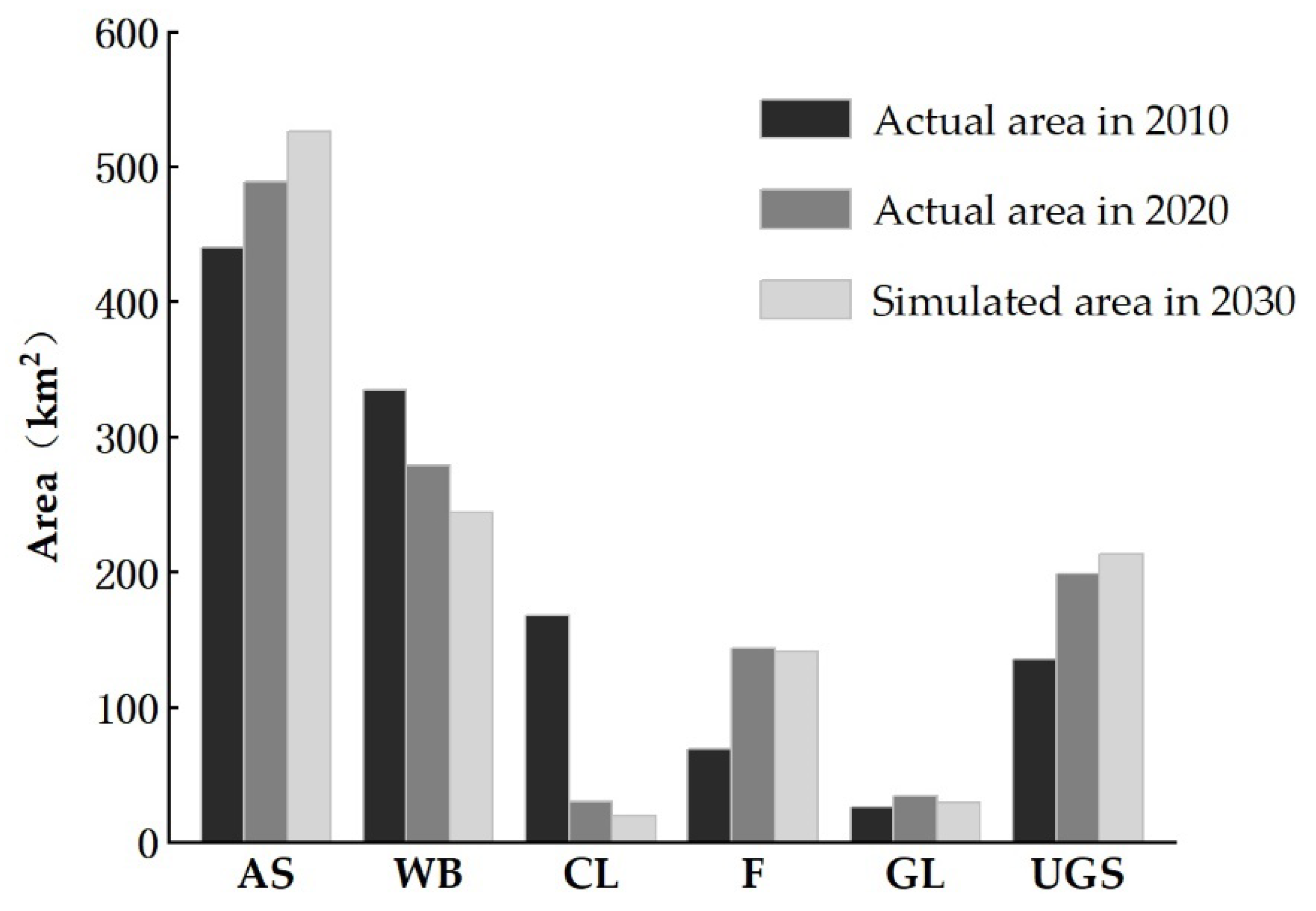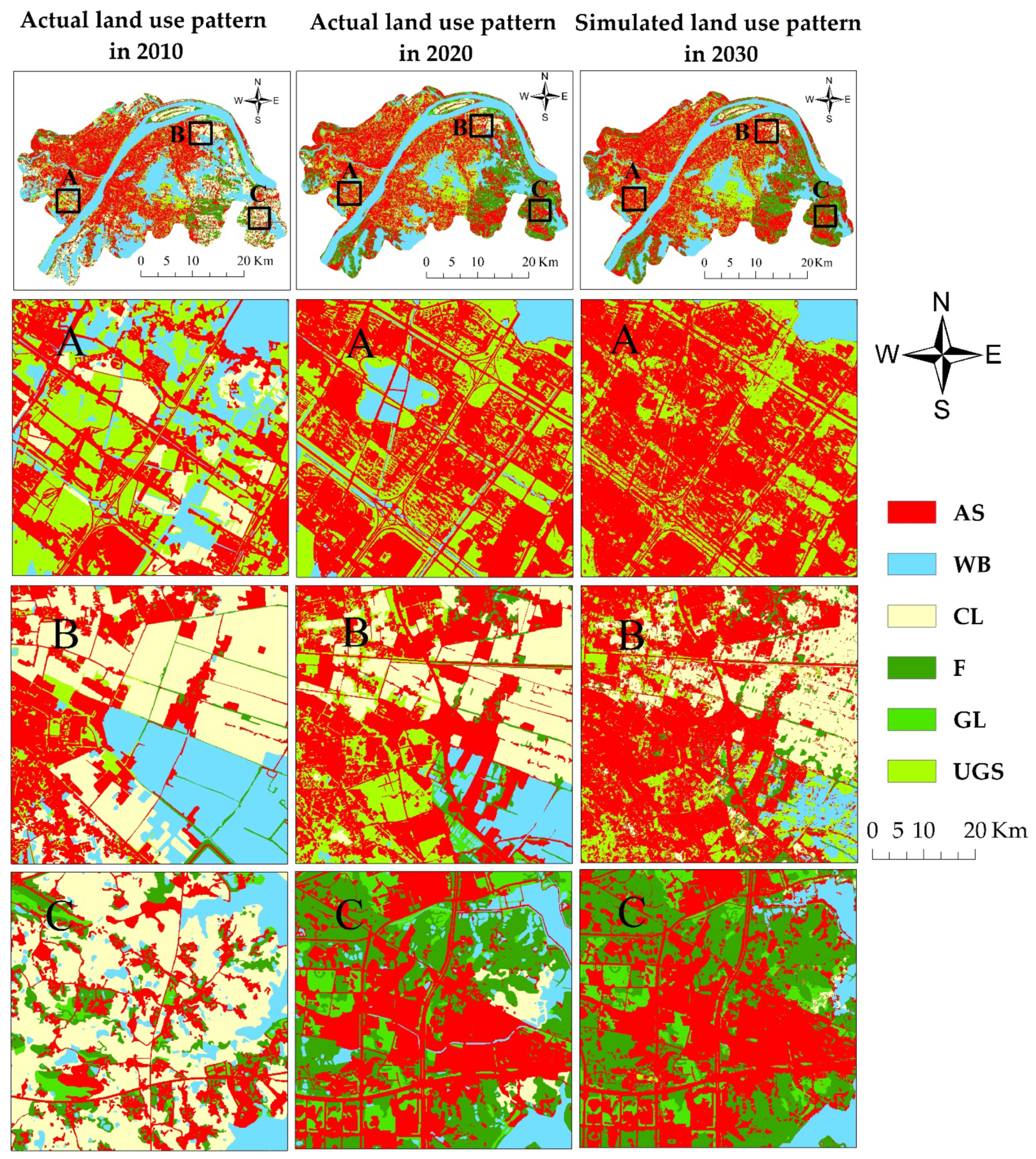3.3.1. Correlation and Collinearity Analysis of Influencing Factors
The process of land use change is highly complex and influenced not only by natural conditions, but also by socio-economic factors and geographic locations; thus, the selection of driving forces should consider data characteristics, such as accessibility, consistency, comprehensiveness, and quantifiability [
34,
35,
36].
The following driving forces were selected in this study: slope, aspect, elevation, population density, and the distances to urban centers, rivers, roads, financial institutions, scenic spots, shopping stores, restaurants, medical institutions, and recreational facilities. To avoid the influence of correlations and collinearity among the driving forces on the model, 1,000,000 samples were randomly selected from the 13 types of driving forces using MATLAB 2017b. The Pearson correlation coefficient (r) and the variance inflation factor (VIF) were calculated using SPSS.
The correlation matrices showed that the distance to shopping stores and financial institutions and that to recreational facilities and restaurants were highly correlated, with the correlation coefficients greater than 0.8. The distance to medical institutions and that to financial institutions and the distance to shopping stores and that to restaurants were moderately correlated, with the correlation coefficients higher than 0.7. The distance to restaurants showed a strong collinearity with that to recreational facilities because the multicollinearity results indicated that the variance inflation factors of these two were greater than 10.
In summary, the following nine factors were selected as input for the logistic and Markov–ANN–CA models: distance to urban centers, rivers, roads, scenic spots, and financial institutions; population density; slope; elevation; and aspect.
3.3.2. Logistic Regression Analysis
A logistic regression analysis calculates the relation between a dependent variable and multiple independent variables to explain the impact and effects of each variable on event occurrence [
37]. In this study, binary logistic regression was used to quantitatively calculate the odd ratio of the driving forces, according to the following formula:
where
–
are the driving forces and
–
are the regression coefficients of the respective driving forces. If
β > 0, the driving factor is positively correlated with the corresponding land use type; otherwise, they are negatively correlated.
The regression coefficient
β cannot directly present the odd ratio; hence, Exp(
β) is introduced to replace
β. If Exp(
β) > 1, the proportion of the land type increases; otherwise, it decreases [
38]. To determine the correlation degree between each land use type and the driving forces, the aforementioned nine driving forces were converted to the ASCII format in ArcGIS10.7, and the presented data were loaded into MATLAB 2017b. One million data records were randomly sampled from the nine driving forces and exported to an Excel file, which was used to extract the binary data of the six land use types. A regression analysis was then performed in SPSS with the nine driving forces as the independent variables and the six land use types as the dependent variables to obtain the odd ratio for each driving force for different land use types (
Table 2). In the table, X
1–X
9 represent the distance to urban centers, water bodies, roads, financial institutions, and scenic spots, population density, slope, elevation, and aspect, respectively.
3.3.3. Land Use Suitability Analysis
The spatial development strategy for land use in Wuhan indicates that maintaining economic growth, protecting resources, and balancing land use and ecological development are important ways of protecting the ecosystem and making good use of the restrictive landscape of Wuhan. Priority must be given to ecological land planning to prevent the irrational expansion of the urban area. Accordingly, the land use simulation of the urban areas of Wuhan requires an evaluation of land use suitability based on natural and socio-economic factors. The obtained suitability of the croplands, forests, and grasslands should be used as the constraint factors in the Markov–ANN–CA model to ensure that the simulation results are consistent with the spatial pattern of the urban areas.
- (1)
Selection of the evaluation factors
Land use suitability is the result of a comprehensive evaluation of several factors that are closely related to the land use types. Six factors were selected considering the odd ratio that was obtained in the logistic regression: distance to roads and water bodies, elevation, slope, aspect, and land use.
- (2)
Ranking and weight of the evaluation factors
Calculating the land use suitability in the case of a large number of evaluation factors and inconsistent attributes is difficult. Therefore, the evaluation factors for each land use type must be graded to keep the factor values within certain ranges. According to previous studies [
39,
40,
41] and considering the topographic and geomorphological characteristics of the urban area of Wuhan, the evaluation factors were graded into five classes, with values 5, 4, 3, 2, and 1 representing the degree of suitability. The larger the value, the higher the degree of suitability.
Table 3,
Table 4 and
Table 5 are the grading standards for the metrics of croplands, forests, and grasslands.
Evaluation factors have been weighted according to the objects, purposes, and contents of the evaluation by using various models in previous studies, such as the analytic hierarchy process (AHP) [
42], logistic regression [
43], fuzzy comprehensive evaluation [
44], and multi-criteria decision analysis [
45]. In this study, the weight of each factor was obtained by AHP based on yahp10.3. First, the evaluation hierarchy was established according to the study area conditions. Second, the judgment matrix between the factors was built according to the logistic regression results. Finally, a consistency check was performed to verify the judgment matrix suitability. When building the judgment matrix, the relative importance of any two factors was determined according to their odd ratio. The weights of the evaluation factors of the suitability of cropland, forest, and grassland are provided in
Table 6.
- (3)
Comprehensive evaluation of land use suitability
The comprehensive evaluation of suitability is a comprehensive analysis of evaluation factors. Each evaluation factor of each land use type is multiplied by its weight and added together to obtain the final evaluation result of the land use suitability. The calculation formula for land use suitability is as follows:
where
means the land use suitability of the
ith cell,
indicates the normalized value of the
th suitability evaluation factor of the
th cell after grading, and
is the weight of the
th evaluation factor.
3.3.4. Markov–ANN–CA Model
A Markov model can simulate the number of future land use types based on the current types and trends, but it cannot simulate the spatial changes of land use [
46]. A CA model can simulate complex temporal and spatial changing processes through a powerful spatial computation; however, its transition rules and model structure are difficult to determine [
47,
48]. An ANN model is suitable for simulating complex nonlinear systems and allows synthetic data training, thereby obtaining a high simulation accuracy [
49,
50,
51]. Combining the three models can give full play to their respective advantages.
The open and dynamic characteristics of urban systems make the relation between urban land use types complex. Therefore, in the land use simulation process, the factors affecting the land use must be considered, and the mapping relation between them and the land use types must be determined. By combining the ANN model and training the neural network, the CA rules and related parameters can be obtained to improve the simulation accuracy and provide a reference basis for urban planning. In this study, MATLAB 2017b was used to integrate the CA, ANN, and Markov models. With the aid of the ANN and Markov models, the shortcomings of the traditional CA model were eliminated, making it possible to simulate and predict land use in the future based on the actual land use changes in the urban areas of Wuhan.
In the modeling process, the tool IDRISI for the Markov model was first used to predict the land use demand in 2030 in the urban areas of Wuhan. This land use demand was further used as the condition to stop the iteration in the land use simulation program. For the prediction, the land use classification data of 2010 and 2020 were loaded into IDRISI software and saved in .rst format in the reclassification module before being input into the Markov tool. Setting the time interval to 10, the transition probability matrix of 2010–2020 was obtained on the basis of 2010 and used for 2030.
The ANN model was then trained with nine driving forces, three constraint factors, the neighbor data of six types of land use, and land use data of 2010 to obtain the transition rules of the CA by using the CA model. In the process of the training of the ANN model and the simulation of the land use in 2020, the CA transition rules were obtained by creating a back-propagation three-layer feed-forward neural network to train the relations between each driving factor and land use types. The neighborhood of a cell is an important factor that affects its change; hence, the neighbor factor of the land use type is also used as a driving factor of the Markov–ANN–CA model. Given the abovementioned driving forces, a 19–16–6 structure is defined for the neural network—that is, 19 driving forces in the input layer, 16 hidden layers, and the transition probability of the six land use types in the output layer. The training function, excitation function for the hidden layer, and excitation function for the output layer are the Levenberg–Marquardt (LM) algorithm, tansig, and logsig, respectively. A total of 300,000 raster cells were randomly selected as the training data from the 2010 land use data of the study area using MATLAB 2017b. When the neural network was trained for 500 iterations, its root mean square error was 0.011084, meeting the accuracy requirement and indicating that the neural network can be used to simulate the land use of the study area in 2020.
The 2010 land use data of the urban areas of Wuhan was input to the trained neural network to calculate the probability of each cell transiting into one of the six land use types. A random variable was introduced to perturb the transition probability, which was then compared with the threshold value to obtain the specific land use type. Subsequently, this process was repeated for the determined land use types until the difference between the quantity of a certain type and that predicted by the Markov model was within 30,000. The simulated land use data of the urban areas of Wuhan in 2020 were then generated.
The driving forces that were selected by the ANN–CA model were associated with the
n attributes of each simulated cell. These attributes collectively determined the probability of the land use transition for each cell at the time
t, expressed by the following formula:
where
is the
th variable of cell
at the time
.
To avoid the training errors caused by a numerical inconsistency, the data input to the ANN model was normalized with the maximum and minimum values before being input to the hidden layer. The calculation formulae are
where
is the value that is received by the
th neuron of the hidden layer from the input layer, and
is the weight of the input and hidden layers.
The signal from the hidden layer to the output layer is the transition probability, which is calculated as follows:
where
denote the probability of the land use transition of cell
from the present type to type
at the simulation time
, and
is the weight of the hidden layer to the output layer.
To make the simulation results more accurate, a random variable is introduced to the CA model with the following expression:
where
is the random number falling in the range of [0, 1], and
is the parameter controlling the random variable value.
Given the abovementioned conditions, the probability of the land use transition of cell
k from the present type to type
l at the simulation time
t is:
The transition probability of each land use type was obtained in each neural network operation cycle. The magnitude of its value represented the transition probability from the current land use type to the other land use types. The larger the value, the higher the transition probability. The values ranged from 0 to 1 during the whole operation. The values of the land use transition probability were small in a short period of time. Several simulations were needed to determine the direction of the land use transition. Therefore, the threshold value T and the random variable
α were used as the parameters for controlling the land use transition. The calculated transition probability was compared with the threshold value. The land use type of the cell was changed when the transition probability of land use was greater than the threshold value. A random number was generated when the transition probability of land use was less than the threshold value. When the random number was greater than 0.5, the land use type corresponding to the maximum transition probability value was output. No transition occurred when the random number was less than 0.5. To verify the accuracy criteria, the Lee–Sallee shape index was used based on the following formula [
52]:
where
is the land use classification of the actual year and
is the land use classification of the simulated year. The simulation result was good when the value of the Lee–Sallee index was between 0.3 and 0.7.
When further exploring the mechanism of the land use changes in the urban areas of Wuhan, the factors with strong correlations and collinearity were first removed by correlation and collinearity analyses. Three constraint factors, namely the suitability of croplands, forests, and grasslands, were obtained by using logistic regression and a suitability analysis to control the disorderly expansion of each land use type. Finally, the coupled Markov–ANN–CA model was built to simulate the land use in 2020 based on the 2010 data. The model was validated by using the actual land use data in 2020 and used to simulate the land use in 2030 in the urban areas of Wuhan. Based on the simulation, we analyzed the land use changes from 2020 to 2030.













